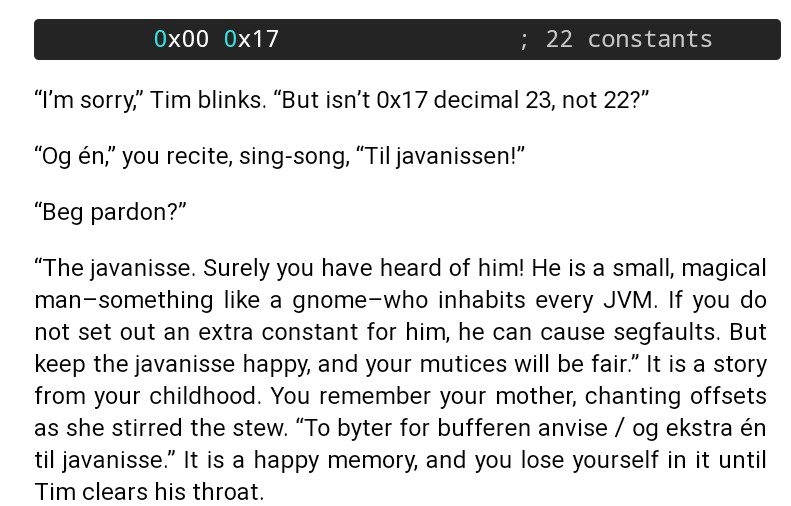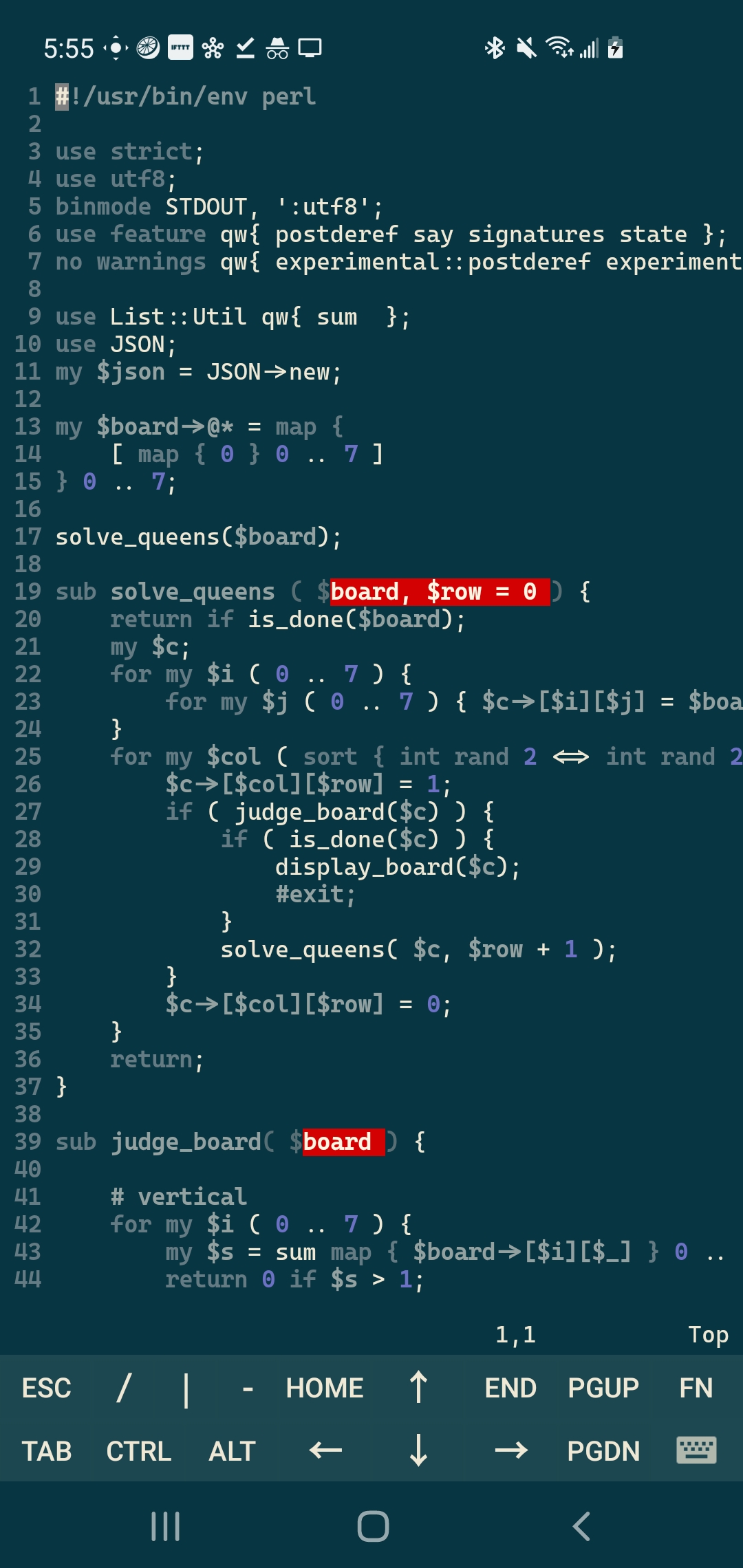Yaas, Queens! Solving the Eight Queens Problem with Recursion
A few years ago, I read something called “Hexing the technical interview” about a long-lived Scandinavian wizard coding her way through a modern coding interview, using the eldritch spells of Java and Clojure.

In a later entry, “Typing the technical interview”, the same character dives deep into the depths of Haskell to solve the Eight Queens problem.
“Are you really unable,” you ask, voice as calm as stone, “to imagine eight powerful women in the same room without them trying to kill each other?”
I am reasonably sure that I have worked on this before, but I decided while sitting on the couch to engage with it again. I, in fact, started engaging the problem on my phone using JuiceSSH.

I just love always having a terminal in my pocket.
I worked on handling the code to display the board and determine if there was a problem, because I knew I was going to go recursive with this problem.
Because it is easy to treat the rows and columns of a two-dimensional array as one dimension, I did just that, using map to just get the eight values in that direction, then sum from List::Util, which I go to so often it’s like a broken record. If the sum is 0 or 1, then everything is fine, but if it’s 2 or greater, then there’s a problem and I return a signal meaning no. I kinda mark it backwards, I think, but oh well.
Because going down the diagonals is harder, I shunt that off to functions diagl and diagr. I double up on the longest diagonal, but it’s O(n) and n equals 8, so it can’t be bad.
I also check if we’re done by flattening a two-dimensional array into a one-dimensional away and running sum on it. sum can be such a useful tool!
This pretty much leaves the actual solving of it, and I try to get every possible solution…
PS C:\Users\jacob> .\8queens.pl
1
# . . . . . . .
. . . . . . # .
. . . . # . . .
. . . . . . . #
. # . . . . . .
. . . # . . . .
. . . . . # . .
. . # . . . . .
2
# . . . . . . .
. . . . . . # .
. . . # . . . .
. . . . . # . .
. . . . . . . #
. # . . . . . .
. . . . # . . .
. . # . . . . .
3
# . . . . . . .
. . . . . # . .
. . . . . . . #
. . # . . . . .
. . . . . . # .
. . . # . . . .
. # . . . . . .
. . . . # . . .
...
90
. . . . # . . .
. # . . . . . .
. . . # . . . .
. . . . . . # .
. . # . . . . .
. . . . . . . #
. . . . . # . .
# . . . . . . .
91
. . # . . . . .
. . . . # . . .
. # . . . . . .
. . . . . . . #
. . . . . # . .
. . . # . . . .
. . . . . . # .
# . . . . . . .
92
. . # . . . . .
. . . . . # . .
. . . # . . . .
. # . . . . . .
. . . . . . . #
. . . . # . . .
. . . . . . # .
# . . . . . . .
PS C:\Users\jacob>
Shub-Internet asserts that there are 92 distinct solutions, so this is it!
Show Me The Code
#!/usr/bin/env perl
use strict;
use utf8;
binmode STDOUT, ':utf8';
use feature qw{ postderef say signatures state };
no warnings qw{ experimental::postderef experimental::signatures };
use List::Util qw{ sum };
use JSON;
my $json = JSON->new;
my $board->@* = map {
[ map { 0 } 0 .. 7 ]
} 0 .. 7;
solve_queens($board);
sub solve_queens ( $board, $row = 0 ) {
return if is_done($board);
my $c;
for my $i ( 0 .. 7 ) {
for my $j ( 0 .. 7 ) { $c->[$i][$j] = $board->[$i][$j]; }
}
for my $col ( 0 .. 7 ) {
$c->[$col][$row] = 1;
if ( judge_board($c) ) {
if ( is_done($c) ) {
state $count = 1;
say $count++;
display_board($c);
}
solve_queens( $c, $row + 1 );
}
$c->[$col][$row] = 0;
}
return;
}
sub judge_board ($board) {
# vertical
for my $i ( 0 .. 7 ) {
my $s = sum map { $board->[$i][$_] } 0 .. 7;
return 0 if $s > 1;
}
# horizontal
for my $i ( 0 .. 7 ) {
my $s = sum map { $board->[$_][$i] } 0 .. 7;
return 0 if $s > 1;
}
#diagonal
for my $i ( 0 .. 7 ) {
my $s1 = sum diagr( $board, $i, 0 );
return 0 if $s1 > 1;
my $s2 = sum diagr( $board, 0, $i );
return 0 if $s2 > 1;
my $s3 = sum diagl( $board, 0, $i );
return 0 if $s3 > 1;
my $s4 = sum diagl( $board, $i, 7 );
return 0 if $s4 > 1;
}
return 1;
}
sub is_done ($board) {
my $x = sum map { $_->@* } $board->@*;
return $x == 8 ? 1 : 0;
}
sub diagl ( $board, $i, $j ) {
my @output;
while ( defined $board->[$i][$j] && $j >= 0 ) {
push @output, $board->[$i][$j];
$i++;
$j--;
}
return @output;
}
sub diagr ( $board, $i, $j ) {
my @output;
while ( defined $board->[$i][$j] ) {
push @output, $board->[$i][$j];
$i++;
$j++;
}
return @output;
}
sub display_board ($board) {
say '';
for my $i ( 0 .. 7 ) {
for my $j ( 0 .. 7 ) {
my $k = $board->[$i][$j];
my $v = $k ? '#' : '.';
print qq{ $v};
}
say '';
}
say '';
}